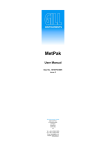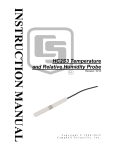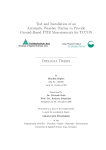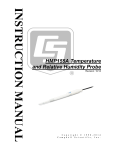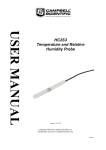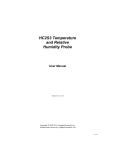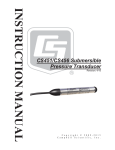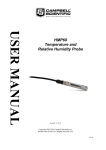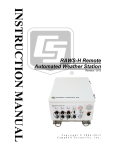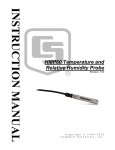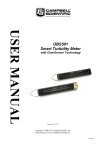Download Campbell cs215 Instruction manual
Transcript
INSTRUCTION MANUAL CS215 Temperature and Relative Humidity Probe Revision: 8/14 C o p y r i g h t © 2 0 0 5 - 2 0 1 4 C a m p b e l l S c i e n t i f i c , I n c . Limited Warranty “Products manufactured by CSI are warranted by CSI to be free from defects in materials and workmanship under normal use and service for twelve months from the date of shipment unless otherwise specified in the corresponding product manual. (Product manuals are available for review online at www.campbellsci.com.) Products not manufactured by CSI, but that are resold by CSI, are warranted only to the limits extended by the original manufacturer. Batteries, fine-wire thermocouples, desiccant, and other consumables have no warranty. CSI’s obligation under this warranty is limited to repairing or replacing (at CSI’s option) defective Products, which shall be the sole and exclusive remedy under this warranty. The Customer assumes all costs of removing, reinstalling, and shipping defective Products to CSI. CSI will return such Products by surface carrier prepaid within the continental United States of America. To all other locations, CSI will return such Products best way CIP (port of entry) per Incoterms ® 2010. This warranty shall not apply to any Products which have been subjected to modification, misuse, neglect, improper service, accidents of nature, or shipping damage. This warranty is in lieu of all other warranties, expressed or implied. The warranty for installation services performed by CSI such as programming to customer specifications, electrical connections to Products manufactured by CSI, and Product specific training, is part of CSI's product warranty. CSI EXPRESSLY DISCLAIMS AND EXCLUDES ANY IMPLIED WARRANTIES OF MERCHANTABILITY OR FITNESS FOR A PARTICULAR PURPOSE. CSI hereby disclaims, to the fullest extent allowed by applicable law, any and all warranties and conditions with respect to the Products, whether express, implied or statutory, other than those expressly provided herein.” Assistance Products may not be returned without prior authorization. The following contact information is for US and international customers residing in countries served by Campbell Scientific, Inc. directly. Affiliate companies handle repairs for customers within their territories. Please visit www.campbellsci.com to determine which Campbell Scientific company serves your country. To obtain a Returned Materials Authorization (RMA), contact CAMPBELL SCIENTIFIC, INC., phone (435) 227-9000. After an application engineer determines the nature of the problem, an RMA number will be issued. Please write this number clearly on the outside of the shipping container. Campbell Scientific’s shipping address is: CAMPBELL SCIENTIFIC, INC. RMA#_____ 815 West 1800 North Logan, Utah 84321-1784 For all returns, the customer must fill out a “Statement of Product Cleanliness and Decontamination” form and comply with the requirements specified in it. The form is available from our web site at www.campbellsci.com/repair. A completed form must be either emailed to [email protected] or faxed to (435) 227-9106. Campbell Scientific is unable to process any returns until we receive this form. If the form is not received within three days of product receipt or is incomplete, the product will be returned to the customer at the customer’s expense. Campbell Scientific reserves the right to refuse service on products that were exposed to contaminants that may cause health or safety concerns for our employees. Precautions DANGER — MANY HAZARDS ARE ASSOCIATED WITH INSTALLING, USING, MAINTAINING, AND WORKING ON OR AROUND TRIPODS, TOWERS, AND ANY ATTACHMENTS TO TRIPODS AND TOWERS SUCH AS SENSORS, CROSSARMS, ENCLOSURES, ANTENNAS, ETC. FAILURE TO PROPERLY AND COMPLETELY ASSEMBLE, INSTALL, OPERATE, USE, AND MAINTAIN TRIPODS, TOWERS, AND ATTACHMENTS, AND FAILURE TO HEED WARNINGS, INCREASES THE RISK OF DEATH, ACCIDENT, SERIOUS INJURY, PROPERTY DAMAGE, AND PRODUCT FAILURE. TAKE ALL REASONABLE PRECAUTIONS TO AVOID THESE HAZARDS. CHECK WITH YOUR ORGANIZATION'S SAFETY COORDINATOR (OR POLICY) FOR PROCEDURES AND REQUIRED PROTECTIVE EQUIPMENT PRIOR TO PERFORMING ANY WORK. Use tripods, towers, and attachments to tripods and towers only for purposes for which they are designed. Do not exceed design limits. Be familiar and comply with all instructions provided in product manuals. Manuals are available at www.campbellsci.com or by telephoning (435) 227-9000 (USA). You are responsible for conformance with governing codes and regulations, including safety regulations, and the integrity and location of structures or land to which towers, tripods, and any attachments are attached. Installation sites should be evaluated and approved by a qualified engineer. If questions or concerns arise regarding installation, use, or maintenance of tripods, towers, attachments, or electrical connections, consult with a licensed and qualified engineer or electrician. General • Prior to performing site or installation work, obtain required approvals and permits. Comply with all governing structure-height regulations, such as those of the FAA in the USA. • Use only qualified personnel for installation, use, and maintenance of tripods and towers, and any attachments to tripods and towers. The use of licensed and qualified contractors is highly recommended. • Read all applicable instructions carefully and understand procedures thoroughly before beginning work. • Wear a hardhat and eye protection, and take other appropriate safety precautions while working on or around tripods and towers. • Do not climb tripods or towers at any time, and prohibit climbing by other persons. Take reasonable precautions to secure tripod and tower sites from trespassers. • Use only manufacturer recommended parts, materials, and tools. Utility and Electrical • You can be killed or sustain serious bodily injury if the tripod, tower, or attachments you are installing, constructing, using, or maintaining, or a tool, stake, or anchor, come in contact with overhead or underground utility lines. • Maintain a distance of at least one-and-one-half times structure height, 20 feet, or the distance required by applicable law, whichever is greater, between overhead utility lines and the structure (tripod, tower, attachments, or tools). • Prior to performing site or installation work, inform all utility companies and have all underground utilities marked. • Comply with all electrical codes. Electrical equipment and related grounding devices should be installed by a licensed and qualified electrician. Elevated Work and Weather • Exercise extreme caution when performing elevated work. • Use appropriate equipment and safety practices. • During installation and maintenance, keep tower and tripod sites clear of un-trained or nonessential personnel. Take precautions to prevent elevated tools and objects from dropping. • Do not perform any work in inclement weather, including wind, rain, snow, lightning, etc. Maintenance • Periodically (at least yearly) check for wear and damage, including corrosion, stress cracks, frayed cables, loose cable clamps, cable tightness, etc. and take necessary corrective actions. • Periodically (at least yearly) check electrical ground connections. WHILE EVERY ATTEMPT IS MADE TO EMBODY THE HIGHEST DEGREE OF SAFETY IN ALL CAMPBELL SCIENTIFIC PRODUCTS, THE CUSTOMER ASSUMES ALL RISK FROM ANY INJURY RESULTING FROM IMPROPER INSTALLATION, USE, OR MAINTENANCE OF TRIPODS, TOWERS, OR ATTACHMENTS TO TRIPODS AND TOWERS SUCH AS SENSORS, CROSSARMS, ENCLOSURES, ANTENNAS, ETC. Table of Contents PDF viewers: These page numbers refer to the printed version of this document. Use the PDF reader bookmarks tab for links to specific sections. 1. Introduction ................................................................. 1 2. Cautionary Statements ............................................... 1 3. Initial Inspection ......................................................... 1 4. Quickstart .................................................................... 2 5. Overview ...................................................................... 4 6. Specifications ............................................................. 4 6.1 6.2 Temperature Measurement................................................................... 5 Relative Humidity Measurement ......................................................... 5 7. Installation ................................................................... 5 7.1 7.2 Wiring to Datalogger ........................................................................... 6 Datalogger Programming ..................................................................... 6 7.2.1 CRBasic Programming ................................................................. 7 7.2.2 Edlog Programming ...................................................................... 7 7.3 Installation............................................................................................ 8 8. Operation ................................................................... 10 8.1 Sensor Measurements ........................................................................ 10 8.1.1 Measurements at Fast Scan Rates ............................................... 10 8.1.1.1 CRBasic Dataloggers ....................................................... 10 8.1.1.2 Edlog Dataloggers ............................................................ 11 8.1.2 Long Cables ................................................................................ 11 8.1.3 Power Conservation .................................................................... 12 8.2 Measuring Multiple SDI-12 Sensors .................................................. 12 9. Troubleshooting and Maintenance ......................... 12 9.1 9.2 9.3 9.4 Troubleshooting ................................................................................. 12 Maintenance ....................................................................................... 13 Calibration.......................................................................................... 13 Sensor Element Replacement ............................................................. 13 10. Attributions and References .................................... 16 i Table of Contents Appendices A. Importing Short Cut Code Into CRBasic Editor ... A-1 A.1 Importing Short Cut Code into a Program Editor............................ A-1 A.1.1 CRBasic Datalogger ................................................................. A-1 A.1.2 Edlog ........................................................................................ A-2 B. Example Programs.................................................. B-1 B.1 CRBasic Programs .......................................................................... B-1 B.1.1 Example CR200(X) Program ................................................... B-1 B.1.2 Example Program for CR800, CR850, CR1000, CR3000, or CR5000............................................................................. B-2 B.2 Edlog Program................................................................................. B-3 C. Environmental Performance .................................. C-1 C.1 C.2 C.3 C.4 Tests to Defined Standards .............................................................. C-1 Exposure to Pollutants ..................................................................... C-1 Operating Range of RH Element..................................................... C-2 Measurement Below 0 °C ............................................................... C-2 D. SDI-12 Sensor Support ........................................... D-1 D.1 SDI-12 Command Basics ................................................................ D-1 D.1.1 Address Query Command (?!) ................................................. D-2 D.1.2 Change Address Command (aAb!) .......................................... D-2 D.1.3 Send Identification Command (aI!) .......................................... D-2 D.1.4 Start Measurement Commands (aM!) ...................................... D-2 D.1.5 Aborting a Measurement Command ........................................ D-2 D.1.6 Send Data Command (aD!) ...................................................... D-2 D.2 SDI-12 Transparent Mode ............................................................... D-2 D.2.1 CR200(X) Series Datalogger Example .................................... D-3 D.2.2 CR1000 Datalogger Example................................................... D-4 D.2.3 CR10X Datalogger Example .................................................... D-5 Figures 7-1. 7-2. 9-1. 9-2. C-1. D-1. D-2. D-3. CS215 and 41303-5A Radiation Shield on a tripod mast .................... 9 CS215 and 41303-5A Radiation Shield on a CM200 Series Crossarm .......................................................................................... 9 Correct fit of sensor element (side view)........................................... 15 Incorrect fit of sensor element (side view) ........................................ 16 Normal operating conditions of RH element ................................... C-2 CR200(X) example of using the SDI-12 transparent mode to change the SDI-12 address from 0 to 1. ....................................... D-3 CR1000 example of using the SDI-12 transparent mode to change the SDI-12 address from 3 to 1. Sensor is connected to control port 1............................................................................ D-4 CR10X example of using the SDI-12 transparent mode to change the SDI-12 address from 0 to 1. Sensor is connected to control port 1............................................................................ D-5 ii Table of Contents Tables 7-1. C-1. D-1. Datalogger Wiring................................................................................ 6 Environmental Tests ........................................................................ C-1 SDI-12 Command and Response Set .............................................. D-1 iii Table of Contents iv CS215 Temperature and Relative Humidity Probe 1. Introduction The CS215 Temperature and Relative Humidity Probe is designed for general meteorological and other data logging applications. It uses the SDI-12 communications protocol to communicate with any SDI-12 recorder, simplifying installation and programming. Before using the CS215, please study • • • 2. 3. Section 2, Cautionary Statements Section 3, Initial Inspection Section 4, Quickstart Cautionary Statements • READ AND UNDERSTAND the Precautions section at the front of this manual. • When opening the shipping package, do not damage or cut the cable jacket. If damage to the cable is suspected, consult with a Campbell Scientific application engineer. • Although rugged, the CS215 should be handled as a precision scientific instrument. • Santoprene® rubber, which composes the black outer jacket of the CS215 cable, will support combustion in air. It is used because of its resistance to temperature extremes, moisture, and UV degradation. It is rated as slow burning when tested according to U.L. 94 H.B. and passes FMVSS302. However, local fire codes may preclude its use inside buildings. Initial Inspection • Check the packaging and contents of the shipment. If damage occurred during transport, immediately file a claim with the carrier. Contact Campbell Scientific to facilitate repair or replacement. • Check model information against the shipping documents to ensure the expected products and the correct lengths of cable are received. Model numbers are found on each product. On cables and cabled items, the model number is usually found at the connection end of the cable. Report any shortages immediately to Campbell Scientific. 1 CS215 Temperature and Relative Humidity Probe 4. Quickstart Short Cut is an easy way to program your datalogger to measure the CS215 sensor and assign datalogger wiring terminals. Use the following procedure to get started. 2 1. Install Short Cut by clicking on the install file icon. Get the install file from either www.campbellsci.com, the ResourceDVD, or find it in installations of LoggerNet, PC200W, PC400, or RTDAQ software. 2. The Short Cut installation should place a shortcut icon on the desktop of your computer. To open Short Cut, click on this icon. 3. When Short Cut opens, select New Program. 4. Select Datalogger Model and Scan Interval. Click Next. CS215 Temperature and Relative Humidity Probe 5. Under the Available Sensors and Devices list, select the Sensors | Meteorological | Relative Humidity & Temperature folder. Select CS215 Temperature & Relative Humidity Sensor. Click to move the selection to the Selected device window. Data defaults to degree Celsius. This can be changed by clicking the Deg C box and selecting Deg F, for degrees Fahrenheit, or K for Kelvin. 6. After selecting the sensor, click at the left of the screen on Wiring Diagram to see how the sensor is to be wired to the datalogger. The wiring diagram can be printed out now or after more sensors are added. 7. Select any other sensors you have, then finish the remaining Short Cut steps to complete the program. The remaining steps are outlined in Short Cut Help, which is accessed by clicking on Help | Contents | Programming Steps. 3 CS215 Temperature and Relative Humidity Probe 5. 8. If LoggerNet, PC400, RTDAQ, or PC200W is running on your PC, and the PC to datalogger connection is active, you can click Finish in Short Cut and you will be prompted to send the program just created to the datalogger. 9. If the sensor is connected to the datalogger, as shown in the wiring diagram in step 6, check the output of the sensor in the datalogger support software data display to make sure it is making reasonable measurements. Overview The CS215 probe uses a single chip element that incorporates both a temperature and an RH sensor. Each element is individually calibrated with the calibration corrections stored on the chip. The element is easily changed in the field. The ability to replace the element in the field reduces downtime and calibration costs. Electronics within the CS215 control the measurement made by the sensor element, apply temperature and linearization corrections to the readings, and present the data via SDI-12 to a datalogger. A sintered plastic filter minimizes the effects of dust and dirt on the sensor. The filter is lightweight and hydrophobic, thereby diminishing its effect on the time response of the sensor. The probe housing is designed to withstand permanent exposure to all weather and to fit into a range of radiation shields, including compact shields. 6. Specifications Features: • Accurate, stable measurements • Field-changeable element allows on-site recalibration • Individually calibrated sensor elements require no further adjustment of the probe • Low power consumption • Digital SDI-12 output • Compatible with Campbell Scientific CRBasic dataloggers: CR200(X) series, CR800 series, CR1000, CR3000, and CR5000. Also compatible with Edlog dataloggers: CR500, CR510, CR10(X), and CR23X 4 Sensor Element: Sensirion SHT75 Supply Voltage: 6 to 16 Vdc Current Consumption: Typically 120 µA quiescent 1.7 mA during measurement Diameter: 12 mm at sensor tip, maximum 18 mm at cable end Length: 180 mm, including cable strain relief Housing Material: Anodized aluminum CS215 Temperature and Relative Humidity Probe 6.1 6.2 Filter Material: Sintered high-density polyethylene, average pore size 13 µm EMC Compliance: Tested and conforms to BS EN61326:2002 Calibration: Sensirion SHT75 sensor element is individually calibrated during manufacture. Temperature Measurement Operating Range: –40 to +70 °C Accuracy: ±0.3 °C at 25 °C ±0.4 °C over 5 to 40 °C ±0.9 °C over –40 to +70 °C Response Time with Filter: 120 s (63% response time in air moving at 1 m/s) Default Units: Degrees Celsius Relative Humidity Measurement Operating Range: 0 to 100% RH (–20 to +60 °C; see Appendix C, Environmental Performance) Accuracy at 25°C: ±2% over 10 to 90% ±4% over 0 to 100% Short-Term Hysteresis: <1% RH Temperature Dependence: Compensated to better than ±2% over –20 to 60 °C Typical Long-Term Stability: Better than ±1.0% per year Response Time with Filter: Environmental Performance: 7. <10 s (63% response time in air moving at 1 m/s at <85% RH) See Appendix C, Environmental Performance Installation If you are programming your datalogger with Short Cut, skip Section 7.1, Wiring to Datalogger, and Section 7.2, Datalogger Programming. Short Cut does this work for you. See Section 4, Quickstart, for a Short Cut tutorial. 5 CS215 Temperature and Relative Humidity Probe 7.1 Wiring to Datalogger TABLE 7-1. Datalogger Wiring Terminal Terminal number Function CR800, CR850, CR1000, CR3000, CR23X, CR10(X), CR500, CR510 CR5000 CR200(X) A 1 12 V power 12V 12V Battery+ A 4 Power Ground G G G B 3 SDI-12 Data Odd Numbered Control Port (C1, C3, …) SDI-12 C1/SDI-12 B 4 SDI-12 Ground G G G To use more than one probe per datalogger, either connect the different probes to different terminals on the datalogger or change the SDI-12 addresses of the probes and wire them to the same terminal. Using the SDI-12 address reduces the use of ports on the datalogger and allows probes to be connected in a “daisy-chain” fashion which can minimize cable runs in some applications. (See below for limits on the total cable length.) The SDI-12 address of the CS215 can be set two ways: 7.2 • By sending the required commands to the sensors via an SDI-12 recorder/datalogger that allows talk through to the sensor (see Appendix D.2, SDI-12 Transparent Mode) • By loading a program into the recorder that sends the required commands Datalogger Programming Short Cut is the best source for up-to-date datalogger programming code. Programming code is needed, • • when creating a program for a new datalogger installation when adding sensors to an existing datalogger program If your data acquisition requirements are simple, you can probably create and maintain a datalogger program exclusively with Short Cut. If your data acquisition needs are more complex, the files that Short Cut creates are a great source for programming code to start a new program or add to an existing custom program. NOTE 6 Short Cut cannot edit programs after they are imported and edited in CRBasic Editor. CS215 Temperature and Relative Humidity Probe A Short Cut tutorial is available in Section 4, Quickstart. If you wish to import Short Cut code into either Edlog or CRBasic Editor to create or add to a customized program, follow the procedure in Appendix A.1, Importing Short Cut Code into a Program Editor. Programming basics for CRBasic and Edlog dataloggers are provided in the following sections. Complete program examples for select dataloggers can be found in Appendix B, Example Programs. 7.2.1 CRBasic Programming The SDI12Recorder() measurement instruction programs CRBasic dataloggers (CR200(X)-, and CR800-series, CR1000, CR3000, and CR5000) to measure the CS215 sensor. This instruction sends a request to the sensor to make a measurement and then retrieves the measurement from the sensor. See Section 8.1, Sensor Measurements, for more information. When using a CR200(X), the SDI12Recorder() instruction has the following syntax: SDI12Recorder(Destination,OutString,Multiplier,Offset) For the other CRBasic dataloggers, the SDI12Recorder() instruction has the following syntax: SDI12Recorder(Destination, SDIPort, SDIAddress, “SDICommand”, Multiplier, Offset) For all of the CRBasic dataloggers, the Destination parameter must be an array of length 2, with the first index for Air Temperature (in °C) and the second for Relative Humidity (as a percent). Variations: • • Temperature reported as °C — set Multiplier to 1 and Offset to 0 Temperature reported as °F — set Multiplier to 1.8 and Offset to 32 7.2.2 Edlog Programming Edlog dataloggers read the CS215 using the SDI12 Recorder (P105) instruction. Please note that Edlog only allocates one input location for the SDI12 Recorder (P105) instruction. Two input locations are required for the SDI-12 M! command. The additional input location needs to be inserted manually using the Input Location Editor. To get into the Input Location Editor, select Edit/Input Labels or press the F5 key. Once in the Input Location Editor, do the following: 1. Choose Edit/Insert Block. 2. After the Insert Block dialog box appears, type in a base name for the input locations. Each input location will have the base name with an underscore and a consecutive number. 3. In the Start Address field, type in the number of the first input location. 4. In the Number of InLocs field, type in 2 and select OK. 7 CS215 Temperature and Relative Humidity Probe 7.3 Installation Locate the sensor over an open, level area at least 9 m (EPA) in diameter. The surface should be covered by short grass or the natural earth surface where grass does not grow. Sensors should be located at a distance of at least four times the height of any nearby obstruction and at least 30 m (EPA) from large paved areas. Sensors should be protected from thermal radiation and adequately ventilated. Protect the filter at the top of the sensor from exposure to liquid water. The hydrophobic nature of the filter repels light rain, but driving rain can force itself into the pore structure of the filter and take time to dry out. Standard measurement heights: • • • 1.5 m (AASC) 1.25 – 2.0 m (WMO) 2.0 m (EPA) See Section 10, Attributions and References, for a list of references that discuss temperature and relative humidity sensors. When used in the field, the CS215 must be housed in a radiation shield. Typically, the 41303-5A six-plate solar radiation shield is used. The white color reflects solar radiation, and the louvered construction allows air to pass freely through, thereby keeping the probe at or near ambient temperature. The 41303-5A attaches to a crossarm, mast, or user-supplied pipe with a 2.5 to 5.3 cm (1.0 to 2.1 inch) outer diameter. A 41003-5 ten-plate solar radiation shield can also house the CS215 sensor by using the 18.5 adapter (pn 6637). For this shield, tighten the sensor grip around the probe where it best matches the size of the grip. (The probe will also fit directly into most of the R.M. Young shields, where the probe enters the shield from the top, pointing downwards.) Both the 41303-5A and the 41003-5 solar radiation shields attach to a crossarm, mast, or user-supplied pipe with a 2.5 to 5.3 cm (1.0 to 2.1 inch) outer diameter. Tools required for installing a radiation shield to a tripod or tower include: • • • • • 8 1/2-inch open-end wrench small screwdriver provided with datalogger small Phillips screwdriver UV-resistant cable ties small pair of diagonal-cutting pliers 1. Loosen the plastic split collar at the base of the shield (reversing the removable portion if necessary) and gently insert the probe. 2. Tighten the collar until it lightly grips the probe body. 3. Continue to push the probe up into the body of the shield until the step in the tube stops it from going any further. CS215 Temperature and Relative Humidity Probe 4. Tighten the collar until it securely grips the probe. 5. Attach the radiation shield to the tripod mast, crossarm, or tower leg using the supplied U-bolt. See FIGURE 7-1 and FIGURE 7-2 for examples of shield mounting. 6. Route the cable to the datalogger, and secure the cable to the mounting structure using cable ties. 41303-5A CS215 Tripod or Tower Mast FIGURE 7-1. CS215 and 41303-5A Radiation Shield on a tripod mast Tripod or Tower Mast 41303-5A CS215 CM200 Series Crossarm FIGURE 7-2. CS215 and 41303-5A Radiation Shield on a CM200 Series Crossarm 9 CS215 Temperature and Relative Humidity Probe 8. Operation 8.1 Sensor Measurements CRBasic instruction SDI12Recorder() measures the CS215 sensor using the Start Measurement (aM!), Concurrent Measurement (aC!), or Continuous Measurement (aR!) command. In all cases “a” is the address of the sensor and “!” is the command terminator. The sensor returns two values: temperature in degrees Celsius and relative humidity as a percentage (0 to 100). A measurement is initiated with the aM! or aC! command. To these commands, the sensor responds with the time until the measurement data are available and the number of values to be returned when one or more subsequent aD! commands are issued. When using the aM! command, the datalogger waits the time specified by the sensor, sends the aD! command, pauses its operation, and waits until either it receives the data from the sensor or the sensor timeout expires. Because of the delays this command requires, it is only recommended in measurement scans of 10 seconds or more. The aC! command follows the same pattern as the aM! command with the exception that it does not require the datalogger to pause its operation until the values are ready. Rather, the datalogger picks up the data with the aD! command on the next pass through the program. Another measurement request is then sent so that data are ready on the next scan. An aR! command switches the sensor to automatically make measurements and send data every 11 seconds, ±2 seconds, based on the sensor’s internal clock. If measurements are requested at 2 seconds or faster, the sensor will increase its measurement rate to approximately every 5 seconds. This instruction usually takes less than 300 milliseconds to execute. The automatic measurement mode can only be cancelled by powering down the sensor to reset it. See Appendix D, SDI-12 Sensor Support, for additional commands and details of the SDI-12 protocol. NOTE Only CS215 sensors with serial numbers after E1587 or those with upgraded firmware support the aR! Command. 8.1.1 Measurements at Fast Scan Rates 8.1.1.1 CRBasic Dataloggers Using the SlowSequence() function allows the SDI-12 instruction to run as a background process, causing minimum interference to other measurements that use the analog hardware. Measuring the sensor in a SlowSequence() section of the program allows faster programs to run as the main scan. NOTE 10 For the CR5000, use a control port rather than the SDI-12 port to allow the SDI12recorder instruction to run in the slow sequence. CS215 Temperature and Relative Humidity Probe 8.1.1.2 Edlog Dataloggers The aM! command takes about 700 milliseconds in total to make a measurement from the CS215. If it is included in the main program table (table 1) the program will be delayed for this interval which will limit the maximum scan rate for fast running programs. For Edlog dataloggers, it is possible to put the SDI-12 instruction in table 2, which allows table 1 to interrupt and pause the SDI-12 instruction letting it run other instructions. However, table 1 cannot interrupt the instruction while SDI-12 communications are taking place, only when datalogger is waiting for the sensor to take the measurement. As the initiation of the sensor and also the transfer of data from the sensor each take approximately 200 milliseconds this limits the scan rate of table 1 to about 250 milliseconds, and only then if table 1 itself takes little time to execute. The aC! concurrent measurement command can also be used where the sensor measurement is initiated with one command and data is collected after a minimum delay of one second or any time thereafter. With Campbell Scientific dataloggers, this is done by using the SDI-12 recorder instruction with the aC! command. The datalogger will return –99999 for the temperature reading for the call of the instruction that initiates the measurement. At the next call of the instruction, the datalogger will request the data and record the correct temperature. Using the aC! command requires more detailed programming to ensure the out-of-range values are not recorded as real temperatures. It also has similar limitations to running the instruction in table 2 when trying to make other measurements at a fast scan rate. This is because the program will still be delayed by approximately 200 ms for both the initiation of the measurement and the subsequent reading of data from the sensor. Using the aC! command can be useful where predictable timing of the program is required (without the complications of working out how different program tables will interrupt each other). 8.1.2 Long Cables Digital data transfer eliminates offset errors due to cable lengths. However, digital communications can break down when cables are too long, resulting in either no response from the sensor or corrupted readings. The original SDI-12 standard specifies the maximum total cable length to be 61 m (200 ft). To ensure proper operation with long cables, follow these guidelines: • Use low capacitance, low resistance, screened cable (as fitted by Campbell Scientific) to reach distances of several hundred meters. • Ensure that the power ground cable has low resistance and is connected to the same ground reference as the datalogger control ports. • Be aware that “daisy-chaining” sensors reduces the maximum cable length roughly in proportion to the number of sensors connected in parallel. 11 CS215 Temperature and Relative Humidity Probe 8.1.3 Power Conservation The CS215 draws less than 70 µA of current between measurements. In most applications, this is insignificant compared to the datalogger and other power uses, so the sensor can be permanently connected. In low-power applications, battery power can be conserved by turning the 12 V supply to the CS215 on just before the measurement (allowing a ‘warm-up’ time of at least 100 ms) and then turning it off afterwards. If available, the switched 12 V output of the datalogger can be used. 8.2 Measuring Multiple SDI-12 Sensors Up to ten CS215s or other SDI-12 sensors can be connected to a single datalogger control port. Each SDI-12 device must have a unique SDI-12 address between 0 and 9. 9. Troubleshooting and Maintenance NOTE 9.1 All factory repairs and recalibrations require a returned material authorization (RMA) and completion of the “Declaration of Hazardous Material and Decontamination” form. Refer to the Assistance page at the beginning of this manual for more information. Troubleshooting Symptom: Temperature is reported as –9999 or NAN, and relative humidity is reported as 0 or as an unchanging value. Recheck wiring. Verify the green wire is connected to the control port specified by the SDI12Recorder() instruction. Verify the red wire is connected to a 12V terminal. Check the voltage to the sensor with a digital voltage meter. If a switched 12V terminal is used, temporarily connect the red wire to a 12V terminal (nonswitched) for test purposes. Verify the probe’s SDI12 address matches the address entered for the SDI12Recorder() instruction. The default address is 0. The address can be verified or changed with the commands described in Appendix D, SDI-12 Sensor Support. Remove the filter tip and verify that the sensing element has been installed with the proper orientation as described in Section 9.4, Sensor Element Replacement. Symptom: Incorrect temperature or relative humidity is reported. If using the SW12 terminal to power the sensor, verify the program is allowing a warm-up time of at least 100 ms. Check to see if the filter tip has been contaminated. Replace the filter tip (pn 18142), or clean with distilled water as needed. 12 CS215 Temperature and Relative Humidity Probe 9.2 Maintenance The CS215 probe requires minimal maintenance. 9.3 • Check the radiation shield monthly to make sure it is free from dust and debris. • Clear the white filter on the end of the sensor of debris. If dirt or salt is engrained into the filter, it should be cleaned with distilled water or replaced. Make sure the filter is connected firmly with your fingers — do not over tighten. Calibration The life of the humidity chip element is quoted as many years with a typical drift of less than 1% per year when used in ‘clean’ environments. Because it can be difficult to know what the sensor has been exposed to and because the element is relatively inexpensive, we recommend replacing the sensor element at the normal interval you would recalibrate similar probes, e.g. annually. Replacing the element effectively brings the probe back to a factory calibration state both for temperature and relative humidity. If you wish to have an old element’s calibration checked in order to formally record the probe’s pre-calibration state (pre-sensor replacement), you can measure its performance by plugging it into another sensor. 9.4 Sensor Element Replacement To replace the element: CAUTION 1. Disconnect the sensor from the 12 V power supply. 2. Remove the filter by unscrewing it in a counter-clockwise direction when looking towards the tip of the sensor. The filter cap unscrews from the probe. Attempting to pull it off will destroy it. 3. NOTE Wash your hands to avoid getting dirt or grease on the element. It is virtually impossible to touch and damage the sensing elements which are enclosed within the black molded plastic at the tip. However, if dirt, salt, or grease are left on the plastic during the process of handling the element, it may influence the measurements made. 4. Identify the sensor element. FIGURE 9-1 shows a side-view of the end of the probe and sensor element. Before removing the element, carefully study the probe, note its orientation, and read the following description: • The element plugs into the black plastic socket that protrudes by about 1 mm from the end of the metal body of the sensor. 13 CS215 Temperature and Relative Humidity Probe CAUTION • There are eight holes in the socket, while the element only has four pins. • The element will work when fitted into either side of socket but must be installed in one of the two possible orientations to work. • The correct orientation is with the black molded tip of the element (that contains the sensing components) mounted directly above the center of the socket. • FIGURE 9-1 shows the correct orientation, while FIGURE 9-2 shows the incorrect orientation. If the sensor is oriented incorrectly, it will not work. The element will draw excessive power from the supply and may be damaged if left powered in this state for more than a few seconds. 5. Grasp the body of the sensor (this also ensures you are at the same electrical potential as the element) and, holding the black tip of the element between your fingertips, pull the element out of the socket. Store the old element in electrostatic protective packaging if you wish to retain it. 6. With the element removed, check for dirt and/or corrosion around the socket. Clean any dirt away using a damp cloth to remove any salts that might be there. 7. Unpack the replacement element, avoiding static discharges to the element by making sure you touch the packaging before the element. 8. Either hold the element by the black top of the package (the other end to the gold plated pins) or use a pair of fine nosed pliers or tweezers to grip the sensor by the pins. Carefully match the pins to the socket in the end of probe. 9. Confirm the correct orientation and gently push the pins into the socket until they will not go in any further. 10. Before replacing the filter element and turning on power to the sensor, double-check that the sensor is inserted in the correct orientation. Refer to FIGURE 9-1. 11. Screw the filter back onto the end of the probe, making sure it clears the sensor element. If the element appears too close to the filter, there is a fair chance that it has been inserted in the incorrect orientation or that the legs of the element have been bent. Screw the filter onto the thread and tighten gently with your fingers. CAUTION 14 Only tighten the filter approximately an eighth of a turn by hand when the filter is fully screwed onto the thread. Overtightening the filter will damage it and cause problems in inserting and removing the probe from some shields. CS215 Temperature and Relative Humidity Probe Sensing part of the element. Printing on this side. Gold colored side of the tip Sensing Element Gold pins Thread for the filter Sensor connector sticking out of the end of the tube Center line of the sensor body and socket FIGURE 9-1. Correct fit of sensor element (side view) 15 CS215 Temperature and Relative Humidity Probe Sensing part of element NOT on the center line Center line of the sensor body FIGURE 9-2. Incorrect fit of sensor element (side view) 10. Attributions and References AASC, 1985: The State Climatologist (1985) Publication of the American Association of State Climatologists: Heights and Exposure Standards for Sensors on Automated Weather Stations, v. 9, No. 4 October, 1985. (www.stateclimate.org/publications/state-climatologist/NOAA-NCYSCBOOKS-SC77097/00000029.pdf) EPA, 2008: Quality Assurance Handbook for Air Pollution Measurement Systems, Vol. IV, Meteorological Measurements, Ver. 2.0, EPA-454/B-08002 (revised 2008). Office of Air Quality Planning and Standards, Research Triangle Park, NC 27711. Goff, J. A. and S. Gratch, 1946: Low-pressure properties of water from -160° to 212°F, Trans. Amer. Soc. Heat. Vent. Eng., 51, 125-164. Lowe, P. R., 1977: An approximating polynomial for the computation of saturation vapor pressure, J. Appl. Meteor., 16, 100-103. 16 CS215 Temperature and Relative Humidity Probe Meyer, S. J. and K. G. Hubbard, 1992: Nonfederal Automated Weather Stations and Networks in the United States and Canada: A Preliminary Survey, Bulletin Am. Meteor. Soc., 73, No. 4, 449-457. Weiss, A., 1977: Algorithms for the calculation of moist air properties on a hand calculator, Amer. Soc. Ag. Eng., 20, 1133-1136. WMO, 2008. Guide to Meteorological Instruments and Methods of Observation. World Meteorological Organization No. 8, 7th edition, Geneva, Switzerland. 17 CS215 Temperature and Relative Humidity Probe 18 Appendix A. Importing Short Cut Code Into CRBasic Editor This tutorial shows: • • How to import a Short Cut program into a program editor for additional refinement How to import a wiring diagram from Short Cut into the comments of a custom program A.1 Importing Short Cut Code into a Program Editor Short Cut creates files that can be imported into either CRBasic Editor or Edlog program editor. These files normally reside in the C:\campbellsci\SCWin folder and have the following extensions: • • • • • • .DEF (wiring and memory usage information) .CR1 (CR1000 datalogger code) .CR8 (CR800 datalogger code) .CR3 (CR3000 datalogger code) .CR7 (CR7 datalogger code) .DLD (contain code for CR10(X), CR23X, CR500, CR510, 21X, or CR7(X) dataloggers) The following procedures show how to import these files for editing. A.1.1 CRBasic Datalogger Use the following procedure to import Short Cut code into CRBasic Editor (CR200(X), CR1000, CR800, CR3000, CR5000 dataloggers). NOTE 1. Create the Short Cut program following the procedure in Section 4, Quickstart. Finish the program and exit Short Cut. Make note of the file name used when saving the Short Cut program. 2. Open CRBasic Editor. 3. Click File | Open. Assuming the default paths were used when Short Cut was installed, navigate to C:\CampbellSci\SCWin folder. The file of interest has a “.CR1”, “.CR8”, “.CR3”, or “.CR5” extension, for CR1000, CR800, CR3000, or CR5000 dataloggers, respectively. Select the file and click Open. 4. Immediately save the file in a folder different from \Campbellsci\SCWin, or save the file with a different file name. Once the file is edited with CRBasic Editor, Short Cut can no longer be used to edit the datalogger program. Change the name of the program file or move it, or Short Cut may overwrite it next time it is used. A-1 Appendix A. Importing Short Cut Code Into CRBasic Editor 5. The program can now be edited, saved, and sent to the datalogger. 6. Import wiring information to the program by opening the associated .DEF file. Copy and paste the section beginning with heading “-Wiring for CRXXX–” into the CRBasic program, usually at the head of the file. After pasting, edit the information such that a ' character (single quotation mark) begins each line. This character instructs the datalogger compiler to ignore the line when compiling the datalogger code. A.1.2 Edlog Use the following procedure to import Short Cut code into the Edlog program editor (CR10(X), CR500, CR510, and CR23X dataloggers). NOTE A-2 1. Create the Short Cut program following the procedure in Section 4, Quickstart. Finish the program and exit Short Cut. Make note of the file name used when saving the Short Cut program. 2. Open Edlog. 3. Click File | Document DLD File. Assuming the default paths were used when Short Cut was installed, navigate to C:\CampbellSci\SCWin folder. The file of interest has a “.DLD” extension. Select the file and click Open. The .dld file, which is a type of ASCII machine code, is imported, documented, and, when saved, given a “.CSI” extension. 4. Immediately save the file in a folder different from \Campbellsci\SCWin, or save the file with a different file name. Once the file is edited with Edlog, Short Cut can no longer be used to edit the program. Change the name of the program file or move it, or Short Cut may overwrite it. 5. The program can now be edited, saved, and sent to the datalogger. 6. Import wiring information to the program by opening the associated .DEF file. Copy and paste the section beginning with heading “-Wiring for CRXXX–” into the Edlog program, usually at the head of the file. After pasting, edit the information such that a ; (semicolon) begins each line, which instructs the datalogger compiler to ignore the line when compiling the datalogger code. Appendix B. Example Programs B.1 CRBasic Programs B.1.1 Example CR200(X) Program This example program shows the measurement of a single CS215 and can be used directly with CR200(X) series dataloggers. 'CR200(X) Series Datalogger 'Program measures one CS215 sensor every 30 seconds and stores the average 'temperature and a sample of relative humidity every 10 minutes. 'Wiring Diagram '============== 'CS215 ' ' ' ' ' ' ' ' Wire Color ----Red Green Black White Clear Function -------Power (12V) SDI-12 signal Power ground Power ground Shield CR200(X) ------Battery + C1/SDI-12 G G AG* '*AG = Analog Ground (represented by ground symbol on CR200 wiring panel 'Declare the variable array for the measurement Public TRHData(2) Alias TRHData(1)=AirTC Alias TRHData(2)=RH Units AirTC=Deg C Units RH=% 'Define a data table for ten-minute data DataTable(TenMin,True,-1) DataInterval(0,10,Min) Average(1,AirTC,False) Sample(1,RH) EndTable 'Main Program BeginProg Scan (30,Sec) 'Scan every 30 seconds 'CS215 Temperature & Relative Humidity Sensor measurements 'AirTC' and 'RH' SDI12Recorder(TRHData(),"0M!",1,0) 'Call Data Tables and Store Data CallTable TenMin NextScan EndProg B-1 Appendix B. Example Programs B.1.2 Example Program for CR800, CR850, CR1000, CR3000, or CR5000 This program can be used directly with CR800 series, CR1000, CR3000, and CR5000 dataloggers. 'Program measures one CS215 sensor every 5 seconds and stores the average 'temperature and a sample of relative humidity every 10 minutes. 'Wiring Diagram '============== 'CS215 ' ' ' ' ' ' ' ' Wire Color ----Red Green Black White Clear Function -------Power (12V) SDI-12 signal Power ground Power ground Shield CR1000 ------12V C3 G G AG* 'Declare the variable array for the measurement Public TRHData(2) Alias TRHData(1)=AirTC Alias TRHData(2)=RH Units AirTC=Deg C Units RH=% 'Define Data Tables DataTable(TenMin,True,-1) DataInterval(0,10,Min,10) Average(1,AirTC,FP2,False) Sample(1,RH,FP2) EndTable 'Main Program BeginProg 'Main Scan Scan(5,Sec,1,0) 'CS215 Temperature & Relative Humidity Sensor measurements 'AirTC' and 'RH' SDI12Recorder(TRHData(),7,"0","M!",1,0) 'Call Data Tables and Store Data CallTable(TenMin) NextScan EndProg B-2 Appendix B. Example Programs B.2 Edlog Program The following example is written for the CR10(X). Programs for the CR500, CR510, and CR23X would be similar. The program below shows a simple example reading a sensor which has been set up with address 0 (the default) and connected to control port 1. ;{CR10X} ;Example program for a CS215 sensor on control port 1 ;Measures every minute and stores some summary statistics ;once per hour *Table 1 Program 01: 60 Execution Interval (seconds) ;Measure the sensor on control port 1 ;Note you have to manually assign the labels in the Inloc Editor ;to make sure two locations are free. 1: SDI-12 Recorder (P105) 1: 0000 SDI-12 Address 2: 00 SDI-12 Command 3: 1 Port 4: 1 Loc [ Temp ] 5: 1. 0 Mult 6: 0.0 Offset ;Now store some statistics. 2: If 1: 2: 3: time is (P92) 0 Minutes (Seconds --) into a 60 Interval (same units as above) 10 Set Output Flag High (Flag 0) 3: Real Time (P77) 1: 111 Day,Hour/Minute,Seconds (midnight = 0000) 4: Average (P71) 1: 1 Reps 2: 1 Loc [ Temp ] 5: Sample (P70) 1: 1 2: 2 Reps Loc [ RH ] *Table 2 Program 02: 0.0000 Execution Interval (seconds) *Table 3 Subroutines End Program B-3 Appendix B. Example Programs B-4 Appendix C. Environmental Performance This appendix details tests and limitations of the sensor when exposed to extremes of the environment. C.1 Tests to Defined Standards The sensor element has been tested by the manufacturer and found to comply with various environmental test standards as shown in the table below: TABLE C-1. Environmental Tests Environment Norm Results Temperature Cycles JESD22-A104-B –40/+125 °C, 1000 cycles Within Specifications HAST Pressure Cooker JESD22-A110-B 2.3bar 125 °C 85%RH Reversible shift by +2% RH Salt Atmosphere DIN-50021SS Within Specifications Condensing Air – Within Specifications Freezing Cycles Fully Submerged –20/+90 °C, 100cycles, 30min dwell time Reversible shift by +2% RH Various Automotive Chemicals DIN 72300-5 Within Specifications Cigarette Smoke Equivalent to 15 years in a mid-size car Within Specifications N.B. The temperature sensor passed all tests without any detectable drift. Package and electronics also passed 100% C.2 Exposure to Pollutants All capacitive sensors are susceptible to pollutants to some degree. The vapors may interfere with the polymer layers used in the structure of the sensing element. The diffusion of chemicals into the polymer may cause temporary or even permanent shifts in both offset and sensitivity. After low levels of exposure, in a clean environment the contaminants will slowly outgas and the sensor recovers. High levels of pollutants may cause permanent damage to the sensing polymer. As a general rule, the sensor will not be damaged by levels of chemicals which are not too dangerous to human health (see TABLE C-1), so damage is not normally a problem in outdoor applications. Avoid exposing the sensor to chemicals at higher concentrations. C-1 Appendix C. Environmental Performance C.3 Operating Range of RH Element The RH sensor is specified to work over the entire humidity range of 0 to 100% RH for the temperature range –20 to +60 °C. It will give readings over an extended range as shown in FIGURE C-1 (although the electronics of the CS215 probe are not specified to operate beyond +70 °C). When used outside the range of normal conditions or when subject to prolonged periods of condensation or freezing, the sensor calibration may be temporarily altered, normally resulting in a change of <+3% RH. Upon returning to normal conditions, the calibration will settle back to the “standard” calibration over the course of several days. In laboratory conditions, it is possible to speed up this process by a reconditioning process, as follows: 80-90 °C at < 5 %RH for 24h (baking) followed by 20 to 30 °C at > 74 %RH for 48h (re-hydration). FIGURE C-1. Normal operating conditions of RH element C.4 Measurement Below 0 °C The CS215 provides a humidity reading that is referenced to the saturated water vapor pressure above liquid water, even at temperatures below 0 °C, where ice might form. This is the common way to express relative humidity and is as defined by the World Meteorological Organization. If an RH value is required to be referenced to ice, the CS215 readings will need to be corrected. One consequence of using water as the reference is that the maximum humidity that will normally be output by the sensor for temperatures below freezing is as follows: 100% RH at 0 °C 95% RH at –5 °C 91% RH at –10 °C 87% RH at –15 °C 82% RH at –20 °C 78% RH at –25 °C 75% RH at –30 °C In practical terms this means that, for instance, at –20 °C the air is effectively fully saturated when the sensor outputs 82% RH. C-2 Appendix D. SDI-12 Sensor Support D.1 SDI-12 Command Basics SDI-12 commands have three components: Sensor address (a) – a single character, and is the first character of the command. The default address of zero (0) can be used unless multiple sensors are connected to the same port. Command body (e.g., M1) – an upper case letter (the “command”) followed by alphanumeric qualifiers. Command termination (!) – an exclamation mark. An active sensor responds to each command. Responses have several standard forms and terminate with <CR><LF> (carriage return – line feed). Standard SDI-12 commands supported by the CS215 are listed in TABLE D-1. TABLE D-1. SDI-12 Command and Response Set Name Command Response Acknowledge Active a! a<CR><LF> Send Identification aI! allccccccccmmmmmmvvvxxx...xx<CR><LF> Change Address aAb! b<CR><LF> Address Query ?! a<CR><LF> Start Measurement aM! atttn<CR><LF> Send Data aD0! a<values><CR><LF> Start verification aV! atttn D-1 Appendix D. SDI-12 Sensor Support D.1.1 Address Query Command (?!) Command ?! requests the address of the connected sensor. The sensor replies to the query with the address, a. D.1.2 Change Address Command (aAb!) Sensor address is changed with command aAb!, where a is the current address and b is the new address. For example, to change an address from 0 to 2, the command is 0A2!. The sensor responds with the new address b, which in this case is 2. D.1.3 Send Identification Command (aI!) Sensor identifiers are requested by issuing command aI!. The reply is defined by the sensor manufacturer, but usually includes the sensor address, SDI-12 version, manufacturer’s name, and sensor model information. Serial number or other sensor specific information may also be included. D.1.4 Start Measurement Commands (aM!) A measurement is initiated with M! commands. The response to each command has the form atttnn, where a = sensor address ttt = time, in seconds, until measurement data are available nn = the number of values to be returned when one or more subsequent D! commands are issued. D.1.5 Aborting a Measurement Command A measurement command (M!) is aborted when any other valid command is sent to the sensor. D.1.6 Send Data Command (aD!) This command requests data from the sensor. It is normally issued automatically by the datalogger after measurement commands aM!. In transparent mode, the user asserts this command to obtain data. D.2 SDI-12 Transparent Mode System operators can manually interrogate and enter settings in probes using transparent mode. Transparent mode is useful in troubleshooting SDI-12 systems because it allows direct communication with probes. Datalogger security may need to be unlocked before transparent mode can be activated. Transparent mode is entered while the PC is in telecommunications with the datalogger through a terminal emulator program. It is easily accessed through Campbell Scientific datalogger support software, but is also accessible with terminal emulator programs such as Windows HyperTerminal. Datalogger keyboards and displays cannot be used. D-2 Appendix D. SDI-12 Sensor Support The terminal emulator is accessed by navigating to the Datalogger menu in PC200W, the Tools menu in PC400, or the Datalogger menu in the LoggerNet Connect screen. The following examples show how to use LoggerNet software to enter transparent mode and change the SDI-12 address of the sensor. The same steps are used to enter transparent mode with PC200W and PC400 software after accessing the terminal emulator as previously described. D.2.1 CR200(X) Series Datalogger Example 1. Connect a single CS215 to the CR200(X) (see TABLE 7-1). 2. In the LoggerNet Connect screen navigate to the Datalogger menu and select Terminal Emulator. The terminal emulator window will open. In the Select Device menu, located in the lower left-hand side of the window, select the CR200Series station. 3. Click on the Open Terminal button. 4. Press the <enter> key until the datalogger responds with the CR2XX> prompt. At the CR2XX> prompt, make sure the All Caps Mode box is checked and enter the command SDI12 <enter>. The response SDI12> indicates that the sensor is ready to accept SDI-12 commands. 5. To query the sensor for its current SDI-12 address, key in ?! <enter> and the sensor will respond with its SDI-12 address. If no characters are typed within 60 seconds, then the mode is exited. In that case, simply enter the command SDI12 again and press <enter>. 6. To change the SDI-12 address, key in aAb! <enter>, where a is the current address from the above step and b is the new address (see FIGURE D-1). The sensor will change its address and the datalogger will respond with the new address. To exit SDI-12 transparent mode, select the Close Terminal button. FIGURE D-1. CR200(X) example of using the SDI-12 transparent mode to change the SDI-12 address from 0 to 1. D-3 Appendix D. SDI-12 Sensor Support D.2.2 CR1000 Datalogger Example 1. Connect a CS215 to the CR1000 (see TABLE 7-1). 2. In the LoggerNet Connect screen navigate to the Datalogger menu and select Terminal Emulator. The terminal emulator window will open. In the Select Device menu, located in the lower left-hand side of the window, select the CR1000 station. 3. Click on the Open Terminal button. 4. Press the <enter> key until the datalogger responds with the CR1000> prompt. At the CR1000> prompt, make sure the All Caps Mode box is checked and enter the command SDI12 <enter>. At the Enter Cx Port 1, 3, 5, or 7 prompt, key in the control port number where the sensor is connected and press <enter>. The response Entering SDI12 Terminal indicates that the sensor is ready to accept SDI-12 commands. 5. To query the sensor for its current SDI-12 address, key in ?! <enter> and the sensor will respond with its SDI-12 address. If no characters are typed within 60 seconds, then the mode is exited. In that case, simply enter the command SDI12 again, press <enter>, and key in the correct control port number when prompted. 6. To change the SDI-12 address, key in aAb! <enter>, where a is the current address from the above step and b is the new address (see FIGURE D-2). The sensor will change its address and the datalogger will respond with the new address. To exit SDI-12 transparent mode, select the Close Terminal button. FIGURE D-2. CR1000 example of using the SDI-12 transparent mode to change the SDI-12 address from 3 to 1. Sensor is connected to control port 1. D-4 Appendix D. SDI-12 Sensor Support D.2.3 CR10X Datalogger Example 1. Connect CS215 to the CR10(X) (see TABLE 7-1). 2. Download a datalogger program that contains the SDI-12 Recorder (P105) instruction with valid entries for each parameter. Make sure that parameter 3 of the P105 instruction matches the control port number where the sensor is connected. 3. In the LoggerNet Connect screen navigate to the Datalogger menu and select Terminal Emulator. The terminal emulator window will open. In the Select Device menu, located in the lower left-hand side of the window, select the CR10X station. 4. Click on the Open Terminal button. 5. Press the <enter> key until the datalogger responds with the * prompt. 6. To activate the SDI-12 Transparent Mode on control port p, enter pX <enter>. For this example, key in 1X <enter>. The datalogger will respond with entering SDI-12. If any invalid SDI-12 command is issued, the datalogger will exit the SDI-12 Transparent Mode. 7. To query the sensor for its current SDI-12 address, enter the command ?!. The sensor will respond with the current SDI-12 address. 8. To change the SDI-12 address, enter the command aAb!; where a is the current address from the above step and b is the new address. The sensor will change its address and the datalogger will exit the SDI-12 Transparent Mode. 9. Activate the SDI-12 Transparent Mode on Control Port 1 again by entering 1X <enter>. Verify the new SDI-12 address by entering the ?! command. The sensor will respond with the new address. 10. To exit the SDI-12 Transparent Mode, enter *. FIGURE D-3. CR10X example of using the SDI-12 transparent mode to change the SDI-12 address from 0 to 1. Sensor is connected to control port 1. D-5 Appendix D. SDI-12 Sensor Support D-6 Campbell Scientific Companies Campbell Scientific, Inc. (CSI) 815 West 1800 North Logan, Utah 84321 UNITED STATES www.campbellsci.com • [email protected] Campbell Scientific Centro Caribe S.A. (CSCC) 300 N Cementerio, Edificio Breller Santo Domingo, Heredia 40305 COSTA RICA www.campbellsci.cc • [email protected] Campbell Scientific Africa Pty. Ltd. (CSAf) PO Box 2450 Somerset West 7129 SOUTH AFRICA www.csafrica.co.za • [email protected] Campbell Scientific Ltd. (CSL) Campbell Park 80 Hathern Road Shepshed, Loughborough LE12 9GX UNITED KINGDOM www.campbellsci.co.uk • [email protected] Campbell Scientific Australia Pty. Ltd. (CSA) PO Box 8108 Garbutt Post Shop QLD 4814 AUSTRALIA www.campbellsci.com.au • [email protected] Campbell Scientific Ltd. (CSL France) 3 Avenue de la Division Leclerc 92160 ANTONY FRANCE www.campbellsci.fr • [email protected] Campbell Scientific (Beijing) Co., Ltd. 8B16, Floor 8 Tower B, Hanwei Plaza 7 Guanghua Road Chaoyang, Beijing 100004 P.R. CHINA www.campbellsci.com • [email protected] Campbell Scientific Ltd. (CSL Germany) Fahrenheitstraße 13 28359 Bremen GERMANY www.campbellsci.de • [email protected] Campbell Scientific do Brasil Ltda. (CSB) Rua Apinagés, nbr. 2018 ─ Perdizes CEP: 01258-00 ─ São Paulo ─ SP BRASIL www.campbellsci.com.br • [email protected] Campbell Scientific Spain, S. L. (CSL Spain) Avda. Pompeu Fabra 7-9, local 1 08024 Barcelona SPAIN www.campbellsci.es • [email protected] Campbell Scientific Canada Corp. (CSC) 14532 – 131 Avenue NW Edmonton AB T5L 4X4 CANADA www.campbellsci.ca • [email protected] Please visit www.campbellsci.com to obtain contact information for your local US or international representative.












































